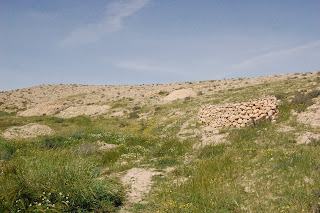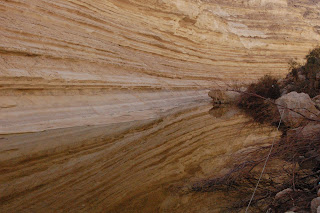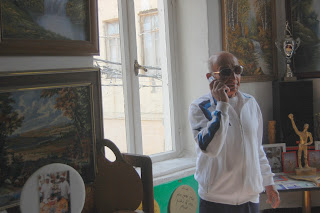Negev 1
Parking says the sign at the Cornfehl (?) Farm. Not seen in the frame is funky little restaurant featuring goat cheese with an outdoor deck overlooking a flower garden and an orchard.
Israel's real Wild West is of course the West Bank but the Negev comes in an honorable second place. The sun dries and cracks and blanches. The winds whip over the mountains and through the wadis and the flash floods carve out new terrain.
A politically aware post about a trip to the Negev should mention the miserable “unrecognized Bedouin villages” to the south and east of Beersheba, the large army firing zones off limits to civilians and what seemed like an inordinate number of prisons. But we were on a weekend getaway and were interested in getting closer to some of the local inhabitants.
Yeruham, perched on the edge of hamchtesh hagadol the Great Crater (diminished to only “Large” on the road sign) is home to a few factories (Negev Ceramica, the Phoenicia Glass Works) and a few thousand people. It's prettier than I had expected, well kept with lawns and lots of trees. On the eastern side of town the road dips into the massive crater and continues into the badlands.It’s restful on the eye to see horizontal lines instead of the vertical ones we’re used to in the city.

On the western side there's a park and a lake with some riotous bird life.
After the heavy rains the ground is still slightly damp underfoot. The wadis are filled with wild flowers and the hills are clothed in a green fuzz. Dotted around Sde Boker and Mitzpeh Ramon single family farms have sprung up (with a bit of help from Arik Sharon) offering accommodation, goats cheese, wine and that rare commodity - peace and quiet for stressed urbanities like us. One place consisted of teepees. Another of mud huts . We stayed in one of these farms: a strip of vineyards, some zimmerim (guest rooms) each with a private wallowing pool, a winery, and a gallery selling ceramics, wine and metalwork. It’s peaceful in the desert, the nothingness gets under the skin and irons out the mind.
In Ein Avdat the soft stone strata are reflected in the soft stream water.
While up the hill in Kibbutz Sdeh Boker, Paula Ben Gurion's kitchen in Ben Gurion's Tzrif (Hut) is also frozen in time. They told me that I couldn't take photographs inside the museum, but I couldn't resist...









Comments
Love the camels, etc.